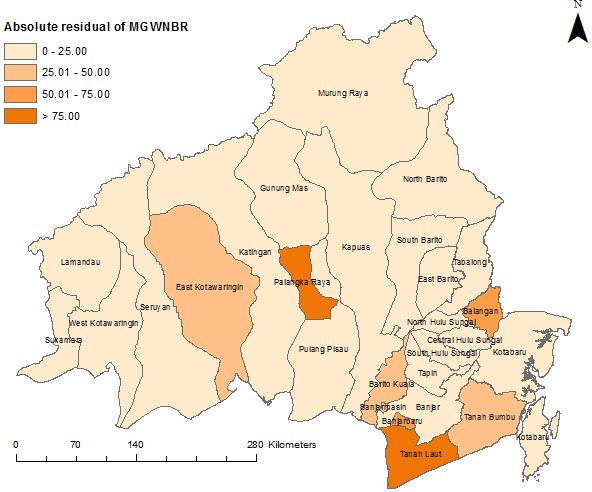Spatial Modelling of Covid-19 Confirmed Cases in Kalimantan, Indonesia: How Neighborhood Matters?
DOI:
https://doi.org/10.48048/wjst.2021.22120Keywords:
Comorbid, Covid-19, GWNBR, Health care facilities, L-BFGS-B, MGWNBRAbstract
The Covid-19 outbreak has hit all countries across the globe, including Indonesia, in which the impact is detrimental and costly. We investigated 14 determinants that could spatially influence Covid-19 cases in Central Kalimantan and South Kalimantan provinces in mid-2020 by using the Geographically Weighted Negative Binomial Regression (GWNBR) and Mixed Geographically Weighted Negative Binomial Regression (MGWNBR). This study conducted iterative Limited-memory Broyden-Fletcher-Goldfarb-Shanno with boundaries (L-BFGS-B) to utilize the numerical parameter estimation of MGWNBR. MGWNBR identified that the adjacent regions tend to group in 8 clusters containing the same significant determinants. Through MGWNBR, the comorbid prevalences (acute respiratory infection, pneumonia, and diabetes) were positively associated with the Covid-19 increasing cases in most regions. The unemployment rate and the number of health care facilities were negatively related to the increase of Covid-19 cases in some regions. MGWNBR was better than GWNBR in terms of AIC, deviance, and pseudo R-sq. The residual map also suggested that MGWNBR produced a more accurate projection than GWNBR.
HIGHLIGHTS
- The statistical models for two Kalimantan provinces of Indonesia during early stage of Covid-19 pandemic
- Those models consisting of global, local, and mixed models estimated the effect of various social, economical, and health determinants on Covid-19 cases
- Mixed model parameters are estimated iteratively using L-BFGS-B weighted by adaptive bisquare kernel weight
- Comparison of models’ performance are applied using deviance, AIC, and pseudo R-sq
GRAPHICAL ABSTRACT
Downloads
Metrics
References
D Kang, H Choi, JH Kim and J Choi. Spatial epidemic dynamics of the COVID-19 outbreak in China. Int. J. Infect. Dis. 2020; 94, 96-102.
LM Andersen, SR Harden, MM Sugg, JD Runkle and TE Lundquist. Analyzing the spatial determinants of local Covid-19 transmission in the United States. Sci. Total Environ. 2021; 754, 142396.
A Hasan and Y Nasution. A compartmental epidemic model incorporating probable cases to model COVID-19 outbreak in regions with limited testing capacity. Isa T. 2021; S0019-0578, 00031-8.
MN Huda, Sifriyani and Fitriani. Real time epidemic modeling using Richards model: Application for the Covid-19 outbreak in East Kalimantan, Indonesia. J. Phys. Conf. Ser. 2021; 1751, 012025.
Satuan Tugas Covid-19 Kalimantan Tengah, Available at: https://mmc.kalteng.go.id/berita/read/31654/perkembangan-terbaru-kasus-covid-19-di-kalteng-sembuh-165-orang-dan-konfirmasi-baru-142-orang, accessed December 2020.
Dinas Kesehatan Provinsi Kalimantan Selatan, Available at: http://dinkes.kalselprov.go.id/berita/informasi-terbaru-covid-19-di-kalimantan-selatan-22-desember-2020.html, accessed December 2020.
WHO Coronavirus Disease 2019 (Covid-19) Indonesia Situation Report - 13, Available at: https://www.who.int/indonesia/news/novel-coronavirus/situation-reports, accessed December 2020.
F Sun, SA Matthews, TC Yang and MH Hu. A spatial analysis of the COVID-19 period prevalence in US counties through June 28, 2020: Where geography matters? Ann. Epidemiol. 2020; 52, 54-9.
E Marhamah and I Jaya. Modeling positive COVID-19 cases in Bandung City by means geographically weighted regression. Commun. Math. Biol. Neurosci. 2020; 2020, 77.
S Mansour, A Al-Kindi, A Al-Said, A Al-Said and P Atkinson. Sociodemographic determinants of COVID-19 incidence rates in Oman: Geospatial modelling using multiscale geographically weighted regression (MGWR). Sustain. Cities Soc. 2020; 65, 102627.
Z Dien, A Saefuddin and A Djuraidah, Modelling the Number of Cases of Dengue Hemorragic Fever with Mixed Geographically Negative Binomial Regression in West Java Province. Int. J. Sci. Eng. Technol. 2019; 6, 71-7.
A Mollalo, B Vahedi and KM Rivera, GIS-based spatial modeling of COVID-19 incidence rate in the continental United States. Sci. Total Environ. 2020; 728, 138884.
AL Kapetanović and D Poljak. 2020. Modeling the epidemic outbreak and dynamics of COVID-19 in Croatia. In: Proceedings of the 5th International Conference on Smart and Sustainable Technologies (SpliTech), Bol, Croatia. 2020, p. 1-5.
JH Claver, NI Séraphin, F Simeon, W Guy, AG Nicolas, ER Malgoire and T Bertrand. Predictive modelling of the COVID-19 epidemic in Cameroon with innovative models. J. Adv. Appl. Math. 2020; 5, 117-37.
MLS Putera, Kausalitas Bivariat antara Nilai Tukar Rupiah dan Indeks Harga Saham Gabungan. Statistika 2019; 19, 103-17.
Downloads
Published
How to Cite
Issue
Section
License

This work is licensed under a Creative Commons Attribution-NonCommercial-NoDerivatives 4.0 International License.













